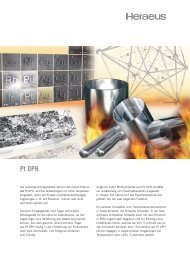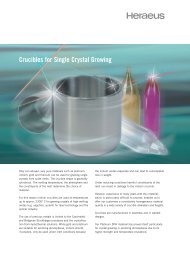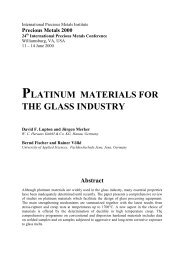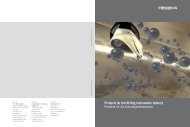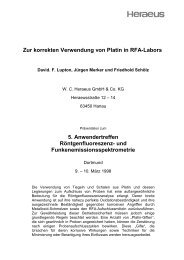Design and Manufacture of Bushings for Glass Fibre Production
Design and Manufacture of Bushings for Glass Fibre Production
Design and Manufacture of Bushings for Glass Fibre Production
Create successful ePaper yourself
Turn your PDF publications into a flip-book with our unique Google optimized e-Paper software.
<strong>Design</strong> <strong>and</strong> <strong>Manufacture</strong> <strong>of</strong> <strong>Bushings</strong> <strong>for</strong> <strong>Glass</strong> <strong>Fibre</strong> <strong>Production</strong><br />
<strong>Design</strong> <strong>and</strong> <strong>Manufacture</strong> <strong>of</strong> <strong>Bushings</strong> <strong>for</strong> <strong>Glass</strong> <strong>Fibre</strong> <strong>Production</strong><br />
by<br />
Michael Koch <strong>and</strong> David Lupton<br />
W. C. Heraeus GmbH<br />
Engineered Materials Division<br />
Heraeusstrasse 12-14<br />
63450 Hanau<br />
Germany<br />
Historical<br />
The method <strong>of</strong> making glass fibres by means <strong>of</strong> a bushing was first demonstrated in<br />
1908 by W. von Paczinsky in Hamburg, although a British silk weaver made a glass<br />
fabric in 1842, <strong>and</strong> another inventor, Edward Libbey, exhibited a dress woven <strong>of</strong><br />
glass at the 1893 Columbian Exposition in Chicago. The manufacture <strong>of</strong> textile glass<br />
fibres using the technique <strong>of</strong> drawing the fibres through very fine orifices was<br />
developed in the 1930s in the USA <strong>and</strong> started in Germany in 1939. A useful<br />
summary <strong>of</strong> the manufacture <strong>and</strong> use <strong>of</strong> glass fibres is given in [1]. Further details<br />
are to be found <strong>for</strong> example in [2 <strong>and</strong> 3].<br />
The earliest bushings used <strong>for</strong> industrial fibre production had 51 individual nozzles or<br />
“tips”. As production processes became more stable, this was increased to 102 <strong>and</strong><br />
then 204 tips. In these early bushings, the tips were arranged in one or more long<br />
rows. Current bushings have up to 4000 tips <strong>and</strong> there is a trend to even larger<br />
numbers. In the most commonly used designs, the tips are arranged in double rows<br />
at right angles to the longitudinal axis <strong>of</strong> the bushing.<br />
Although bushings have been manufactured from a wide range <strong>of</strong> materials in the<br />
course <strong>of</strong> development, alloys <strong>of</strong> platinum with rhodium have proved to be the<br />
optimum choice because <strong>of</strong> their unique combination <strong>of</strong> high temperature strength<br />
with excellent resistance to oxidation by the surrounding air <strong>and</strong> corrosion resistance<br />
to the molten glass. Heraeus has been manufacturing bushings <strong>for</strong> textile glass fibre<br />
production since 1970.<br />
What are glass fibre bushings <strong>and</strong> how do they work?<br />
<strong>Bushings</strong> are, in their simplest <strong>for</strong>m, boxes made from platinum alloys <strong>and</strong> having a<br />
large number <strong>of</strong> small nozzles or tips on their underside. Typically, the tips have an<br />
internal diameter between 1.5 <strong>and</strong> 4 mm. The bushing is fixed in place by means <strong>of</strong><br />
insulating refractory cement <strong>and</strong> is maintained at the operating temperature by direct<br />
resistance heating. <strong>Glass</strong> is maintained in a molten state with closely controlled<br />
viscosity inside the bushing <strong>and</strong> flows slowly through the tips under the influence <strong>of</strong><br />
gravity. It is, <strong>of</strong> course, essential that the temperature over the whole <strong>of</strong> the bushing<br />
– 1 –



